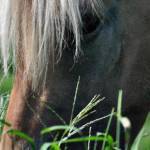Differences Between Grasses and Legumes as Forage for Horses

As horses graze through a pasture, they are likely to encounter a mixture of grasses, legumes, and weeds. This variety is not a problem for horses, as they are likely to sample most of the available forage plants. Though some weeds are tasty and contribute vitamins to the equine diet, owners who conscientiously manage horse pastures are likely to prefer growing grasses and legumes over weeds.
Grasses such as timothy, orchard grass, fescue, and Bermuda have more structural matter in their leaves. Legumes—primarily clover and alfalfa (lucerne)—have leaves with less structural material and are generally higher in protein, energy, and calcium than grasses. The fiber in grass tends to be more digestible by horses than the fiber in legumes, which have higher lignin content per unit of fiber.
Legumes become less leafy and more stemmy as they mature. Conversely, grass leaves become more lignified as they mature, and are therefore less digestible. In some species of grass, the stems may become more digestible than the leaves as maturity increases.








